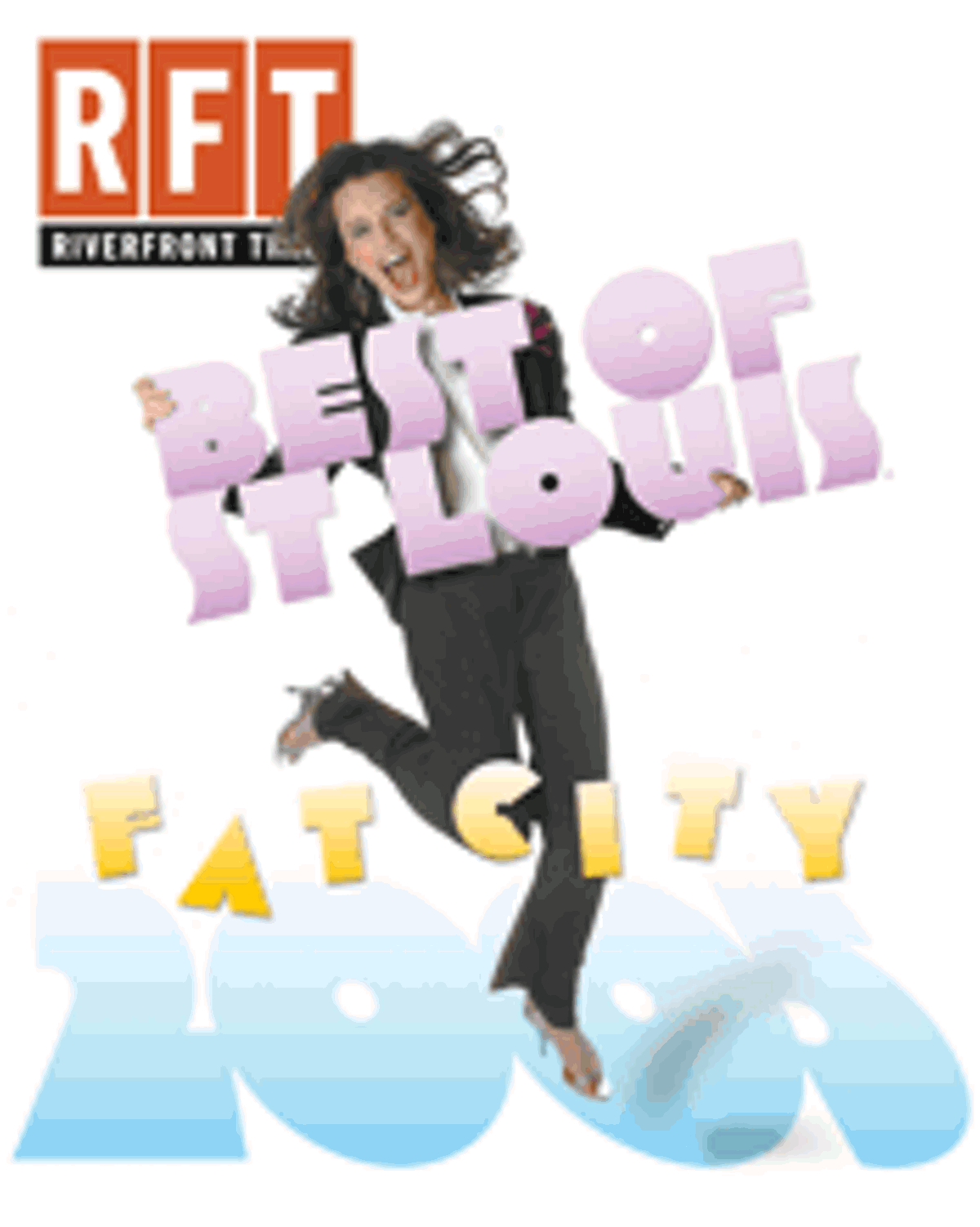OK, so Opera Theatre of Saint Louis isn't a scrappy, underfunded arts organization in need of publicity -- any more. Since its humble beginnings in 1976, Opera Theatre has become one of the most celebrated arts groups in the United States, with its performances routinely reviewed by the New York Times, the Wall Street Journal and the Times of London. In a very American twist on conventional opera, the theater performs all its works in English, accompanied by music from members of the Saint Louis Symphony Orchestra. Highlights from this past season included a stripped-down-perfect production of Charles Gounod's Romeo and Juliet and Benjamin Britten's 1953 gem Gloriana, which RFT opera writer Lew Prince lauded as the embodiment of "technical, spiritual and artistic unity." Adding to the charm is OSTL's location in the intimate 987-seat Loretto-Hilton Center at Webster University, where many operagoers meet prior to performances for picnics on the campus lawn.
It doesn't take a rocket scientist to deduce that the same group who took home this year's "Best Rock Band" honors should logically also win "Best Local Album" -- especially when said honoree is Riddle of Steel. Often cited as one of the loudest live bands in town, the trio shows dynamic range and subtlety on its June-released sophomore platter, Got This Feelin'. Sure, hints of Queens of the Stone Age's lumbering stoner-rock wind through the bottom-heavy riffs and the Josh Homme-esque monotone-but-melodic vocals on "Baby Bird" and "The Lovers of Nothing." But elsewhere the group adds intricate fretwork that reeks of prog rock, while "Invisible Hands" even sounds as spacey and chiming as early-'90s Britrockers Catherine Wheel -- and justifies the shout-out quintessential mopers the Smiths receive in Feelin's liner notes.
Readers' Choice: If the Cigarette Smoke Doesn't Kill You, the Hairspray Will (Rushmore Academy)
Readers' Choice: If the Cigarette Smoke Doesn't Kill You, the Hairspray Will (Rushmore Academy)
Although "In Ya Face" has a spectacularly raunchy chorus -- "Now would you let me put my ass in ya face?/If I let ya bend me over by the waist?" -- "Ebony Eyez" Williams is quick to point out that it's a sarcastic response to a dude who decided to work his sleaze mojo on her at a club. But even if the song wasn't such a potent rallying cry for women, we'd still agree that the song, well, bangs. When we first heard its crunchy beat and deftly spit verses, we were pumped, but when we heard that the TrackBoyz-produced jam had broken nationally, we were foaming at the mouth: The Lou's rap hitting streak -- Nelly, Chingy, Murphy Lee, J-Kwon and now Ebony -- had been preserved.
Readers' Choice: "Manhattan," Westcott
Readers' Choice: "Manhattan," Westcott
Laumeier Sculpture Park turns 30 next year, but it looks fresher than ever. Some of the finest outdoor works have recently been restored; now it's a pleasure, rather than a pity, to contemplate installations by Ursula von Rydingsvard, Beverly Pepper and Jackie Ferrara, among the works of dozens of others scattered throughout the 98-acre museum. Laumeier also showcased some of last year's finest exhibitions in its indoor spaces, from Material Terrain to the phenomenal Sol LeWitt show and Christina Shmigel's Chinese Garden for the Delights of Roaming Afar, the third installment of the impressive Kranzberg Exhibition Series. And there's no indication that Laumeier intends to rest on these laurels. Director Glen Gentele and the museum's board recently completed a long-term strategic plan that envisions an even brighter future for the park. And did we mention that admission is free?
DJ Trackstar's mixtapes are actually CDs, and he sells them for a buck a pop at a few area merchants. His mixes feature a combination of local and national artists rapping over hit tracks. The whole thing is illegal, actually. Major record labels, however, turn a blind eye to the lawlessness because of a hit tape's ability to build street cred for budding rappers (50 Cent was signed on the basis of a hot mixtape). Vol. 4 features 50 (!) local rappers (the best being Finsta, Vandalyzm, Tucker Booth and Nite Owl) chiming in for about a minute a piece. Combined, the rhymes cascade as styles clash and flow for the duration. Haters and rockers who say that all rappers sound the same need only listen to this beast to be proven wrong. Despite a few fumbles and a little too much bitch-speak, the collection demonstrates (yet again) the profound depth and breadth of the St. Louis rap scene.
By virtue of its name change, the former Washington University Gallery of Art now qualifies as a museum, but it matters not: Inside Out Loud was the best exhibition anywhere this year. Curated by Janine Mileaf of Swarthmore College, this incredible survey brought together poetic and harrowing works by an impressive roster of artists including Orlan, Gran Fury, Nan Goldin, Mark Dion, Hannah Wilke and Cindy Sherman. But Inside Out Loud was more than an exhibition: It was a choreographed concert of art shows, symposia, films, plays and music, staged throughout the region to invite us to think about women's lives and women's health. And it will remain a paradigm to follow for anyone wishing to marshal cultural forces toward social and political awareness.
With his big braids and big smile, Spaide is everywhere -- car shows, clubs, picnics, even orphanages. His ubiquitous street team is composed of eight women, ages seventeen to twenty-one, and their daughters, and they hand out swag galore at these events -- everything from Spaide CDs to Spaide towels. Spaide's yet to break out on a national level, though his single, "Always," gets play on a handful of mainstream radio stations around the nation. It's the Lou where big Spaide gets his love -- well, here and Boonville, where he played to a bar full of bikers earlier this year on a bill with Ruka Puff. "Our crews were the only black people there," recalls Spaide. But it was all good. "They clapped for us at the end!" See, even leathered classic-rock fans can't help but fall under the spell of "Da People's Champ." Maybe it's because he doesn't go in much for profanity or samples. Maybe it's because he's got a track with Juvenile. Or maybe it's because he's -- sorry Spaide! -- so damn cute.
Say you're a well-established art museum in a large-ish Midwestern town. You're not particularly known for showing experimental art in the newer media, but you'd like to be. You have no galleries to spare, but you do have some funky extra space at the top of a stairwell. What do you do? If you're the Saint Louis Art Museum, and you're smart enough to have hired Robin Clark as associate curator of contemporary art, you take that funky space, call it Gallery 301 and use it to house a New Media Series. All of a sudden you're showing hip things like Hiraki Sawa's beautiful, silent digital video Migration (2003), Dara Friedman's video loop Government Cut Freestyle (1998) and Shannon Kennedy's incredible 1997 untitled video of microscopic life forms. SLAM's New Media Series proves that big improvements can come from relatively small investments. Other St. Louis institutions, take heed.
DJ Crucial founded F5 Records in 1999 and currently runs it with Andrew "Roo" Yawitz. The label has had great years -- like 2001, when it released Crucial and Hi-Fidel's seminal Traveling Between St. Louis and Chicago, and 2002, when it put out Serengeti's Dirty Flamingo. But Crucial and Roo have day jobs, and there are months at a time when F5 seems to fall completely off the face of the earth. Which makes it all the more impressive that this year the local hip-hop label put out its most hard-hitting product yet. One was "Gingerbread Man," a joint release with Day by Day Entertainment featuring indie-god MF Doom; the other, "Coronation," was even better, featuring Juice over a Kenautis Smith beat. Crucial contributed beats and production, but, more important, he organized these collaborations, ripping up the map in the process -- St. Louis comes together with New York City, Chicago and Atlanta. Crucial deserves props not just for his studio work: His residencies at Modai Lounge and Blueberry Hill's Friday night sock hop "The Science" rock as well.
St. Louis is fortunate to possess a thriving art scene, a variety of venues and a roster of artists both well-established and up-and-coming. Some of these artists are making big, splashy noises and poised on the brink of art stardom, and they're finally getting their due. This year the decidedly modest, unsplashy Brandon Anschultz deserves to be recognized too. Anschultzes have been exhibited all over town for a few years now, but the muted, cerebral quality of his work sometimes gets lost in the shuffle of group exhibits. He typically paints small shapes in restrained colors on highly varnished plywood boards, shifting flirtatiously between hoosier and high-modernist aesthetic. Last spring Anschultz had the luxury of mounting a solo, three-room painting and video installation, *Scape, in the Contemporary Project Gallery at the Saint Louis University Museum of Art. *Scape was a meditation on the structure of memory and the art of city- and landscapes. Another, more ironic, commentary on the contemporary cityscape came in the form of faux wood siding Anschultz plastered onto a white Ford minivan: Country Squire, Anschultz's contribution to Lisa Bulawsky's too-short-lived Blind Spot public art initiative, made stinging reference to suburbia's hollow pastoral symbolism. In addition to producing his own work, Anschultz, a 2002 Washington University MFA, commits a great deal of his energy to organizing art shows around St. Louis; he curated the recent Matthew Wallis exhibition and organized a show by San Francisco sculptor John Eric Richardson in 2003 at Fort Gondo Compound for the Arts. For all this, Anschultz is entitled to at least a sliver of the spotlight he's used to not getting.









